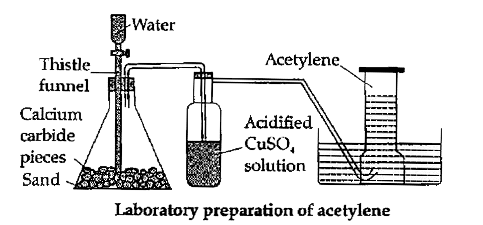What happens to limestone on heating?
Step-by-Step Text Solution:
1. Understanding Limestone: Limestone is primarily composed of calcium carbonate (CaCO3). It is a common sedimentary rock.
2. Heating Limestone: When limestone is subjected to high temperatures (around 1273 Kelvin), it undergoes a thermal decomposition reaction.
3. Decomposition Reaction: During this process, calcium carbonate (CaCO3) decomposes into two products:
- Calcium oxide (CaO), which is a solid and commonly known as quicklime.
- Carbon dioxide (CO2), which is a gas.
4. Chemical Equation: The decomposition can be represented by the following chemical equation:
CaCO3(s)heat−−→CaO(s)+CO2(g)
Here, (s) denotes a solid state and (g) denotes a gaseous state.
5. Naming the Compounds:
- CaCO3 is known as calcium carbonate, which is commonly referred to as limestone.
- CaO is known as calcium oxide or quicklime.
- CO2 is known as carbon dioxide.
6. Conclusion: Therefore, upon heating limestone, it decomposes to form calcium oxide and carbon dioxide gas.
---
- Calcium oxide (CaO), which is a solid and commonly known as quicklime.
- Carbon dioxide (CO2), which is a gas.
CaCO3(s)heat−−→CaO(s)+CO2(g)
Here, (s) denotes a solid state and (g) denotes a gaseous state.
- CaCO3 is known as calcium carbonate, which is commonly referred to as limestone.
- CaO is known as calcium oxide or quicklime.
- CO2 is known as carbon dioxide.
Topper's Solved these Questions
- CHEMICAL REACTIONS BOOK - ICSECHAPTER - CHEMICAL REACTIONS EXERCISE - Exercise (Tick the most appropriate answer)
10 Videos
- CHEMICAL REACTIONS BOOK - ICSECHAPTER - CHEMICAL REACTIONS EXERCISE - Exercise (Fill in the blanks)
8 Videos
- CHEMICAL REACTIONS BOOK - ICSECHAPTER - CHEMICAL REACTIONS EXERCISE - TEST YOURSELF - 2
1 Videos
- CARBON AND ITS COMPOUNDS BOOK - ICSECHAPTER - CARBON AND ITS COMPOUNDS EXERCISE - EXERCISES (E NAME THE FOLLOWING)
10 Videos
- ELEMENTS , COMPOUNDS AND MIXTURES BOOK - ICSECHAPTER - ELEMENTS , COMPOUNDS AND MIXTURES EXERCISE - Think and answer
3 Videos
Similar Questions
What happens when boron is heated in air?
View SolutionWhat happens when toluene is heated with acidified KMnO4
View SolutionWhat happens when ZnO is heated in a current of CO .
View SolutionWhat happens when quick lime is heated with silica ?
View SolutionWhat happens when
sodium is heated in a current of hydrogen
View SolutionWhat happens when PCl5 is heated?
View SolutionWhat happens to a metal ball when it is heated? What does this show?
View SolutionWhat happens when iron is heated under pressure in an atmosphere of carbon monoxide .
View Solution
What happens when acetylene is heated in copper tube at 600∘C?
View SolutionWhat happens to conductance of solution of a weak electrolyte , when heated
View Solution
